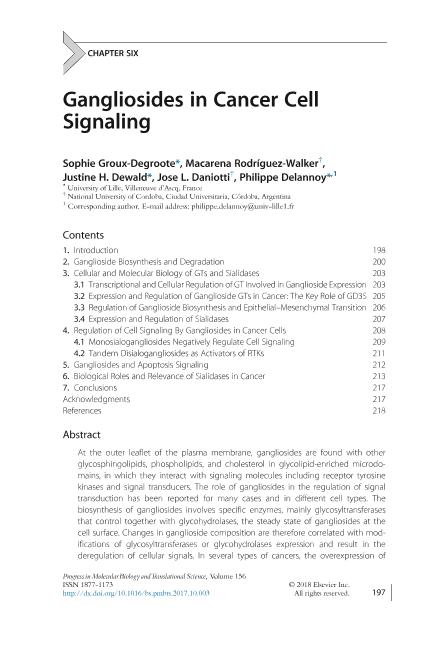Artículo
Gangliosides in Cancer Cell Signaling
Groux-Degroote, Sophie; Rodríguez Walker, Macarena ; Dewald, Justine H.; Daniotti, Jose Luis
; Dewald, Justine H.; Daniotti, Jose Luis ; Delannoy, Philippe
; Delannoy, Philippe
 ; Dewald, Justine H.; Daniotti, Jose Luis
; Dewald, Justine H.; Daniotti, Jose Luis ; Delannoy, Philippe
; Delannoy, Philippe
Fecha de publicación:
01/2018
Editorial:
Elsevier B.V.
Revista:
Progress in Molecular Biology and Translational Science
ISSN:
0079-6603
e-ISSN:
1878-0814
Idioma:
Inglés
Tipo de recurso:
Artículo publicado
Clasificación temática:
Resumen
At the outer leaflet of the plasma membrane, gangliosides are found with other glycosphingolipids, phospholipids, and cholesterol in glycolipid-enriched microdomains, in which they interact with signaling molecules including receptor tyrosine kinases and signal transducers. The role of gangliosides in the regulation of signal transduction has been reported for many cases and in different cell types. The biosynthesis of gangliosides involves specific enzymes, mainly glycosyltransferases that control together with glycohydrolases, the steady state of gangliosides at the cell surface. Changes in ganglioside composition are therefore correlated with modifications of glycosyltransferases or glycohydrolases expression and result in the deregulation of cellular signals. In several types of cancers, the overexpression of disialogangliosides, such as GD3 or GD2 mainly results in the activation of cell signaling, increasing cell proliferation and migration, as well as tumor growth. In this chapter, we summarize our current knowledge of ganglioside biosynthesis, degradation, and of their role in cell signaling regulation in cancers.
Archivos asociados
Licencia
Identificadores
Colecciones
Articulos(CIQUIBIC)
Articulos de CENTRO DE INVEST.EN QCA.BIOL.DE CORDOBA (P)
Articulos de CENTRO DE INVEST.EN QCA.BIOL.DE CORDOBA (P)
Citación
Groux-Degroote, Sophie; Rodríguez Walker, Macarena; Dewald, Justine H.; Daniotti, Jose Luis; Delannoy, Philippe; Gangliosides in Cancer Cell Signaling; Elsevier B.V.; Progress in Molecular Biology and Translational Science; 156; 1-2018; 197-227
Compartir
Altmétricas



